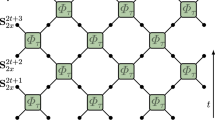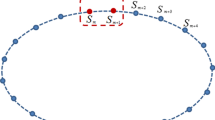Abstract
This study investigates the nonlinear dynamics of a pair of exchange-coupled spins with biaxial exchange and single-site anisotropy. It represents a Hamiltonian system with 2 degrees of freedom for which we have already established the (nontrivial) integrability criteria and constructed the integrals of the motion provided they exist. Here we present a comparative study of the phase-space trajectories for two specific models with the same symmetry properties, one of which (the XY model with exchange anisotropy) is integrable, and the other (the XY model with single-site anisotropy) nonintegrable. In the integrable model, the integrals of the motion (analytic invariants) can be reconstructed numerically by means of time averages of dynamical variables over all trajectories. In the nonintegrable model, such time averages over trajectories define nonanalytic invariants, where the nonanalyticities are associated with the presence of chaotic trajectories. A prominent feature in the nonintegrable model is the occurrence of very long time scales caused by the presence of low-flux cantori, which form “sticky” coats on the boundary between chaotic regions and regular islands or “leaky” walls between different chaotic regions. These cantori dominate the convergence properties of time averages and presumably determine the long-time asymptotic properties of dynamic correlation functions. Finally, we present a special class of integrable systems containing arbitrarily many spins coupled by general biaxial exchange anisotropy.
Similar content being viewed by others
References
Magyari, E., Thomas, H., Weber, R., Kaufman, C., Müller, G.: Z. Phys. B-Condensed Matter65, 363 (1987)
Preliminary results of the present study have appeared in conference proceedings: Srivastava, N., Kaufman, C., Müller, G., Magyari, E., Weber, R., Thomas, H.: J. Appl. Phys.61, 4438 (1987)
Chaotic behavior in quantum systems: theory and applications. Casati, G. (ed.). New York: Plenum Press 1985
Müller, G.: Phys. Rev. A34, 3345 (1986)
Magneto-structural correlations in exchange coupled systems. Willett, R.D., Gatteschi, D., Kahn, O. (eds.). Boston: Reidel 1985
Kent, T.A., Huynh, B.H., Münck, E.: Proc. Natl. Acad. Sci. USA77, 6674 (1980) Girerd, J.J., Papaefthymiov, G.C., Watson, A.D., Gamp, E., Hagen, K.S., Edelstein, N., Frankel, R.B., Holm, R.H.: J. Am. Chem. Soc.1984, 5941 (1984)
De Jongh, L.J. Magneto-structural correlations in exchange coupled systems. Boston: Reidel 1985 p. 1
N independent integrals of the motion in involution can be chosen as follows:\(I_1 = \sum\limits_{l'} {S_{l'}^z ,I_l = S_l \cdot \left( {S_1 + S_2 + \ldots + S_{l - 1} } \right),l = 2, \ldots ,N} \),I l =Sl·(S1+S2+...+S l−1),l=2,...,N. Note that the set of invariants given in (3.49) of [1] are, in fact, not all in involution
In several cases the nonintegrability of these clusters has been verified numerically
Nakamura, K., Bishop, A.R.: Phys. Rev. B33, 1963 (1986)
Nevertheless, for all initial conditions on the special energy hypersurfaceE=0, the azimuthal spin motion is absent: φ1=φ2≡0, and the remaining meridional motion is periodic, again expressible in terms of Jacobi elliptic functions
In some regions of phase space there is more than one value φ (0)2 for given values of ϑ (0)1 , ϑ (0)2 , φ (0)1 andE; in other regions there is no value at all. For the construction of Fig. 3 (and also of Fig. 4) it is important to ensure that all the values of φ (0)2 chosen result in trajectories which are located (in the Poincaré cut) on the same sheet of the energy surface projected onto the (ϑ1, φ1) plane
There appears to be no simple symmetry consideration leading to an exact determination of the periodic trajectories associated with the two elliptic fixed points in Fig. 3b. In any event, our numerical calculation of these periodic trajectories do not seem to give us the clue to an analytic solution. They merely tell us thatS z2 and φ2 are odd functions ofS z1 , φ1, respectively, withS z1 S z2 ≦0 and φ1 φ2≦0
In fact, the elliptic fixed point in Fig. 4a corresponds to a periodic trajectory of symmetryPC x2 and the hyperbolic fixed point to one of symmetryPC y2
Cantori are invariant Cantor sets. Under the influence of an increasing nonintegrable perturbation (in our case, α increasing from zero), invariant tori with irrational frequency ratios are not immediately destroyed like their rational counterparts. However, at some threshold of the nonintegrable perturbation, an irrational torus starts to degenerate into a Cantor set while it retains its invariant character but loses the property of being an impenetrable barrier to the chaotic phase flow. Nevertheless, the phase flow through the infinitely many holes of a cantorus can be extremely weak
This property does, of course, not hold for isolated periodic trajectories within chaotic regions such as the ones represented by the primary hyperbolic fixed points in Fig. 4a and b
Depending on the number of decimal places used in the numerical integration
Combined with an increasing number of digits used in the execution of theRK4[dt] integration
Only if the time step of the chaotic itinerary is chosen unreasonably large do we find the unphysical phenomenon that a chaotic itinerary turns into a regular one at some point along the way. Once turned regular, the exponential error propagation disappears and the regular itinerary is stable. Under such circumstances, one might say that regular itineraries act effectively like attractors. However, for reasonably small time steps we have not observed this phenomenon in our calculations. A likely mechanism which prevents this from happening is that as a chaotic itinerary approaches an invariant torus the rate of exponential error propagation becomes smaller, so small that the error is always too small to allow it to jump onto the torus. A similar phenomenon was described previously by Chirikov, B.V., Izraelev, F.M.: Physica2D, 30 (1981) and Chirikov, B.V., Shepalyansky, D.L.: Physica13D, 395 (1984). They discuss the capture of chaotic trajectories by regular regions under the influence of weak dissipation
Khinchin, A.I.: Mathematical foundations of statistical mechanics, p. 19. New York: Dover 1949; Abraham, R., Marsden, J.E.: Foundation of mechanics, 2nd ed., p. 238. Reading: Benjamin/Cummings 1985
Since the dashed line in Fig. 3c, on which the initial conditions used for Fig. 6 are equally spaced, is, in fact, the projection of a curved line on the energy surface in 3D(ϑ1, φ1, φ2)-space, additional singularities in the curves of Fig. 6 may be caused by points where the line of initial conditions has infinite slope with respect to the projection plane
Chirikov, B.V., Shepalyanski, D.L.: Physica13D, 395 (1984)
Hanson, J.D., Cary, J.R., Meiss, J.D.: J. Stat. Phys.39, 327 (1985)
Meiss, J.D., Ott, E.: Physica20D, 387 (1986)
Author information
Authors and Affiliations
Rights and permissions
About this article
Cite this article
Srivastava, N., Kaufman, C., Müller, G. et al. Integrable and nonintegrable classical spin clusters. Z. Physik B - Condensed Matter 70, 251–268 (1988). https://doi.org/10.1007/BF01318307
Received:
Issue Date:
DOI: https://doi.org/10.1007/BF01318307




